2001 CHRYSLER VOYAGER fuse
[x] Cancel search: fusePage 1163 of 4284
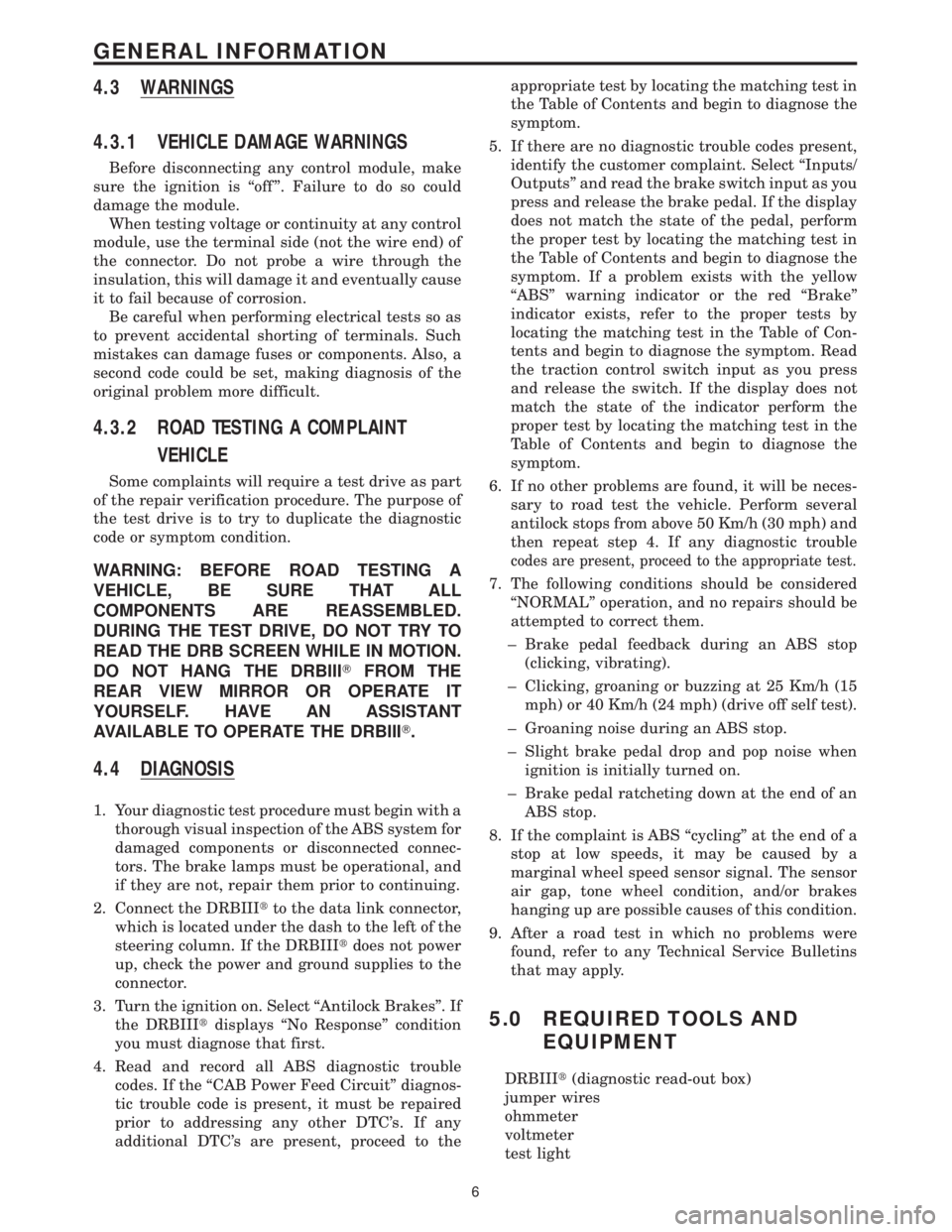
4.3 WARNINGS
4.3.1 VEHICLE DAMAGE WARNINGS
Before disconnecting any control module, make
sure the ignition is ``off ''. Failure to do so could
damage the module.
When testing voltage or continuity at any control
module, use the terminal side (not the wire end) of
the connector. Do not probe a wire through the
insulation, this will damage it and eventually cause
it to fail because of corrosion.
Be careful when performing electrical tests so as
to prevent accidental shorting of terminals. Such
mistakes can damage fuses or components. Also, a
second code could be set, making diagnosis of the
original problem more difficult.
4.3.2 ROAD TESTING A COMPLAINT
VEHICLE
Some complaints will require a test drive as part
of the repair verification procedure. The purpose of
the test drive is to try to duplicate the diagnostic
code or symptom condition.
WARNING: BEFORE ROAD TESTING A
VEHICLE, BE SURE THAT ALL
COMPONENTS ARE REASSEMBLED.
DURING THE TEST DRIVE, DO NOT TRY TO
READ THE DRB SCREEN WHILE IN MOTION.
DO NOT HANG THE DRBIIITFROM THE
REAR VIEW MIRROR OR OPERATE IT
YOURSELF. HAVE AN ASSISTANT
AVAILABLE TO OPERATE THE DRBIIIT.
4.4 DIAGNOSIS
1. Your diagnostic test procedure must begin with a
thorough visual inspection of the ABS system for
damaged components or disconnected connec-
tors. The brake lamps must be operational, and
if they are not, repair them prior to continuing.
2. Connect the DRBIIItto the data link connector,
which is located under the dash to the left of the
steering column. If the DRBIIItdoes not power
up, check the power and ground supplies to the
connector.
3. Turn the ignition on. Select ªAntilock Brakesº. If
the DRBIIItdisplays ªNo Responseº condition
you must diagnose that first.
4. Read and record all ABS diagnostic trouble
codes. If the ªCAB Power Feed Circuitº diagnos-
tic trouble code is present, it must be repaired
prior to addressing any other DTC's. If any
additional DTC's are present, proceed to theappropriate test by locating the matching test in
the Table of Contents and begin to diagnose the
symptom.
5. If there are no diagnostic trouble codes present,
identify the customer complaint. Select ªInputs/
Outputsº and read the brake switch input as you
press and release the brake pedal. If the display
does not match the state of the pedal, perform
the proper test by locating the matching test in
the Table of Contents and begin to diagnose the
symptom. If a problem exists with the yellow
ªABSº warning indicator or the red ªBrakeº
indicator exists, refer to the proper tests by
locating the matching test in the Table of Con-
tents and begin to diagnose the symptom. Read
the traction control switch input as you press
and release the switch. If the display does not
match the state of the indicator perform the
proper test by locating the matching test in the
Table of Contents and begin to diagnose the
symptom.
6. If no other problems are found, it will be neces-
sary to road test the vehicle. Perform several
antilock stops from above 50 Km/h (30 mph) and
then repeat step 4. If any diagnostic trouble
codes are present, proceed to the appropriate test.
7. The following conditions should be considered
ªNORMALº operation, and no repairs should be
attempted to correct them.
± Brake pedal feedback during an ABS stop
(clicking, vibrating).
± Clicking, groaning or buzzing at 25 Km/h (15
mph) or 40 Km/h (24 mph) (drive off self test).
± Groaning noise during an ABS stop.
± Slight brake pedal drop and pop noise when
ignition is initially turned on.
± Brake pedal ratcheting down at the end of an
ABS stop.
8. If the complaint is ABS ªcyclingº at the end of a
stop at low speeds, it may be caused by a
marginal wheel speed sensor signal. The sensor
air gap, tone wheel condition, and/or brakes
hanging up are possible causes of this condition.
9. After a road test in which no problems were
found, refer to any Technical Service Bulletins
that may apply.
5.0 REQUIRED TOOLS AND
EQUIPMENT
DRBIIIt(diagnostic read-out box)
jumper wires
ohmmeter
voltmeter
test light
6
GENERAL INFORMATION
Page 1169 of 4284
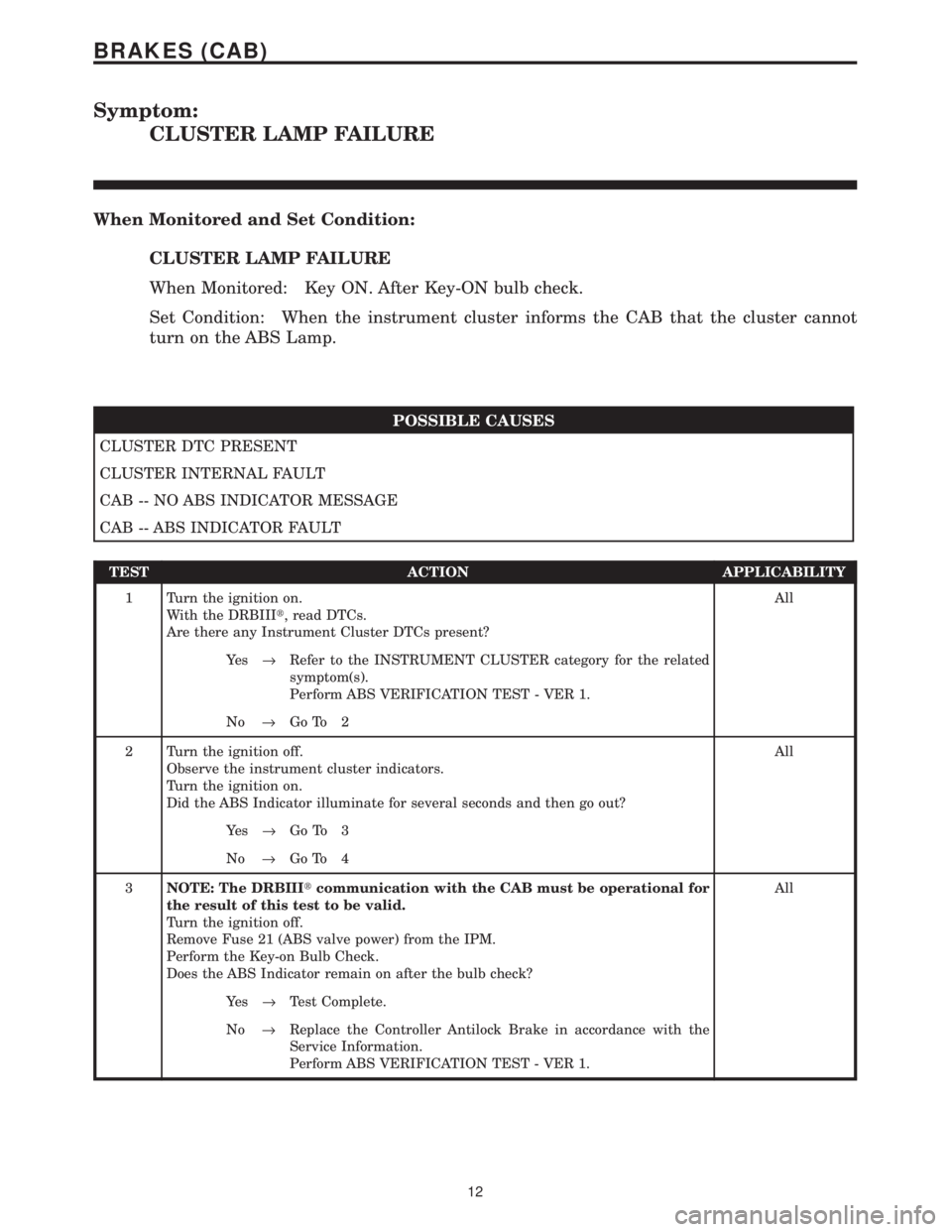
Symptom:
CLUSTER LAMP FAILURE
When Monitored and Set Condition:
CLUSTER LAMP FAILURE
When Monitored: Key ON. After Key-ON bulb check.
Set Condition: When the instrument cluster informs the CAB that the cluster cannot
turn on the ABS Lamp.
POSSIBLE CAUSES
CLUSTER DTC PRESENT
CLUSTER INTERNAL FAULT
CAB -- NO ABS INDICATOR MESSAGE
CAB -- ABS INDICATOR FAULT
TEST ACTION APPLICABILITY
1 Turn the ignition on.
With the DRBIIIt, read DTCs.
Are there any Instrument Cluster DTCs present?All
Ye s®Refer to the INSTRUMENT CLUSTER category for the related
symptom(s).
Perform ABS VERIFICATION TEST - VER 1.
No®Go To 2
2 Turn the ignition off.
Observe the instrument cluster indicators.
Turn the ignition on.
Did the ABS Indicator illuminate for several seconds and then go out?All
Ye s®Go To 3
No®Go To 4
3NOTE: The DRBIIItcommunication with the CAB must be operational for
the result of this test to be valid.
Turn the ignition off.
Remove Fuse 21 (ABS valve power) from the IPM.
Perform the Key-on Bulb Check.
Does the ABS Indicator remain on after the bulb check?All
Ye s®Test Complete.
No®Replace the Controller Antilock Brake in accordance with the
Service Information.
Perform ABS VERIFICATION TEST - VER 1.
12
BRAKES (CAB)
Page 1178 of 4284

Symptom:
PUMP CIRCUIT FAILURE
When Monitored and Set Condition:
PUMP CIRCUIT FAILURE
When Monitored: Ignition on. The CAB commands the pump on at 20 km/h (12 mph) to
check its operation, if the brake switch is not applied. If the brake is applied, the test will
run at 40 km/h (25 mph). The CAB monitors pump voltage every 7 milliseconds.
Set Condition: The DTC is stored when the CAB detects: 1) Improper voltage decay after
the pump was turned off. 2) Pump not energized by the CAB, but voltage is present for 3.5
seconds. 3) Pump is turned on by the CAB, but without sufficient voltage to operate it.
POSSIBLE CAUSES
PUMP HARNESS DISCONNECTED
CAB - PUMP MOTOR RUNNING CONTINUOUSLY
ABS PUMP MOTOR INTERMITTENT DTC
GROUND CIRCUIT HIGH RESISTANCE
FUSED B(+) CIRCUIT OPEN
GROUND CIRCUIT OPEN
CAB - INTERNAL FAULT
CAB - SETTING FALSE CODE
TEST ACTION APPLICABILITY
1 Turn the ignition off.
Turn the ignition on.
Monitor the pump motor for continuous operation.
Is the pump motor running continuously?All
Ye s®Replace the Controller Anti-Lock Brake in accordance with the
Service Information. The vehicle must be driven at 25 km/h (15
mph) to extinguish the ABS indicator.
Perform ABS VERIFICATION TEST - VER 1.
No®Go To 2
2 Turn the ignition on.
With the DRBIIIt, read DTC's.
With the DRBIIIt, erase DTC's.
Turn the ignition off.
Turn the ignition on.
With the DRBIIIt, actuate the ABS pump motor.
Did the Pump Motor operate when actuated?All
Ye s®Go To 3
No®Go To 4
21
BRAKES (CAB)
Page 1180 of 4284
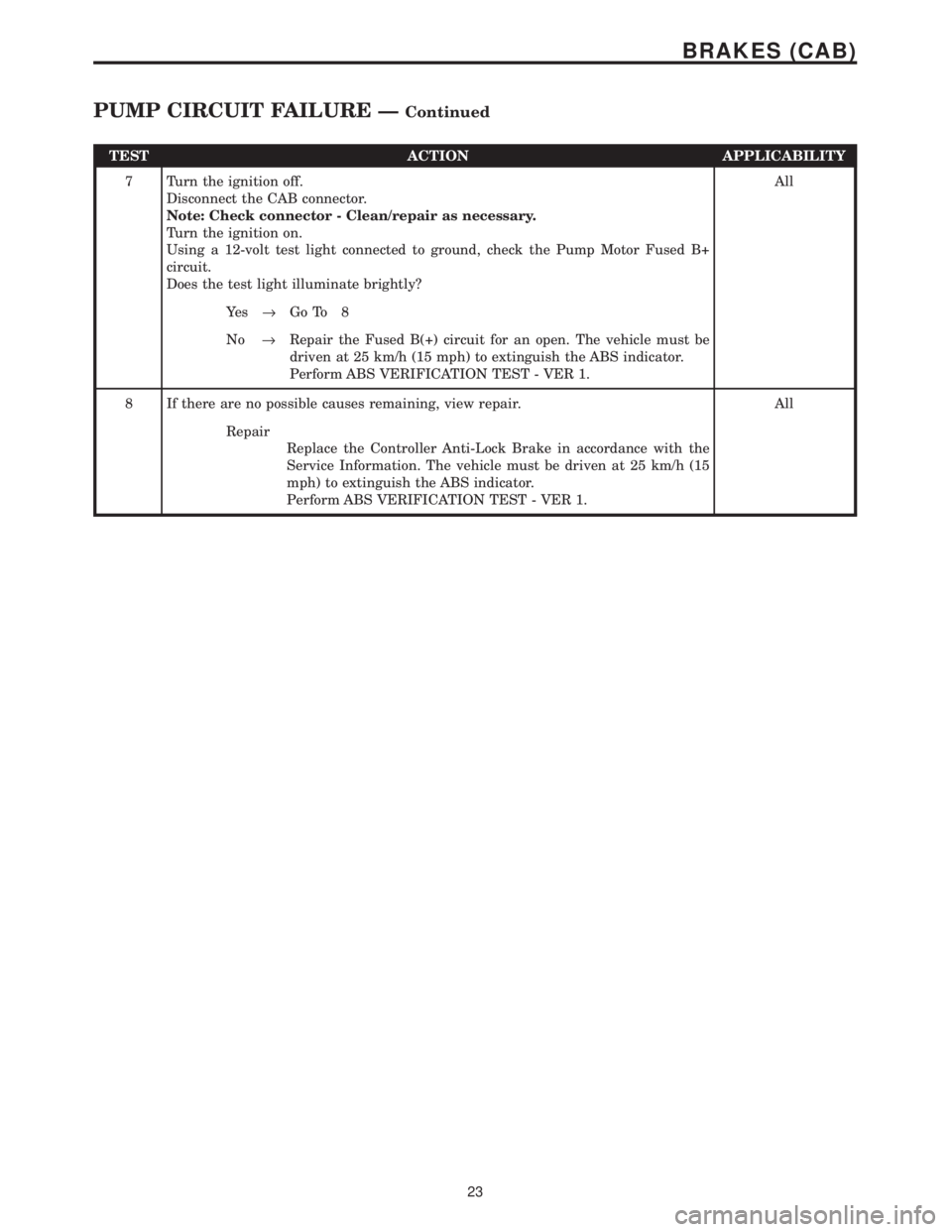
TEST ACTION APPLICABILITY
7 Turn the ignition off.
Disconnect the CAB connector.
Note: Check connector - Clean/repair as necessary.
Turn the ignition on.
Using a 12-volt test light connected to ground, check the Pump Motor Fused B+
circuit.
Does the test light illuminate brightly?All
Ye s®Go To 8
No®Repair the Fused B(+) circuit for an open. The vehicle must be
driven at 25 km/h (15 mph) to extinguish the ABS indicator.
Perform ABS VERIFICATION TEST - VER 1.
8 If there are no possible causes remaining, view repair. All
Repair
Replace the Controller Anti-Lock Brake in accordance with the
Service Information. The vehicle must be driven at 25 km/h (15
mph) to extinguish the ABS indicator.
Perform ABS VERIFICATION TEST - VER 1.
23
BRAKES (CAB)
PUMP CIRCUIT FAILURE ÐContinued
Page 1185 of 4284
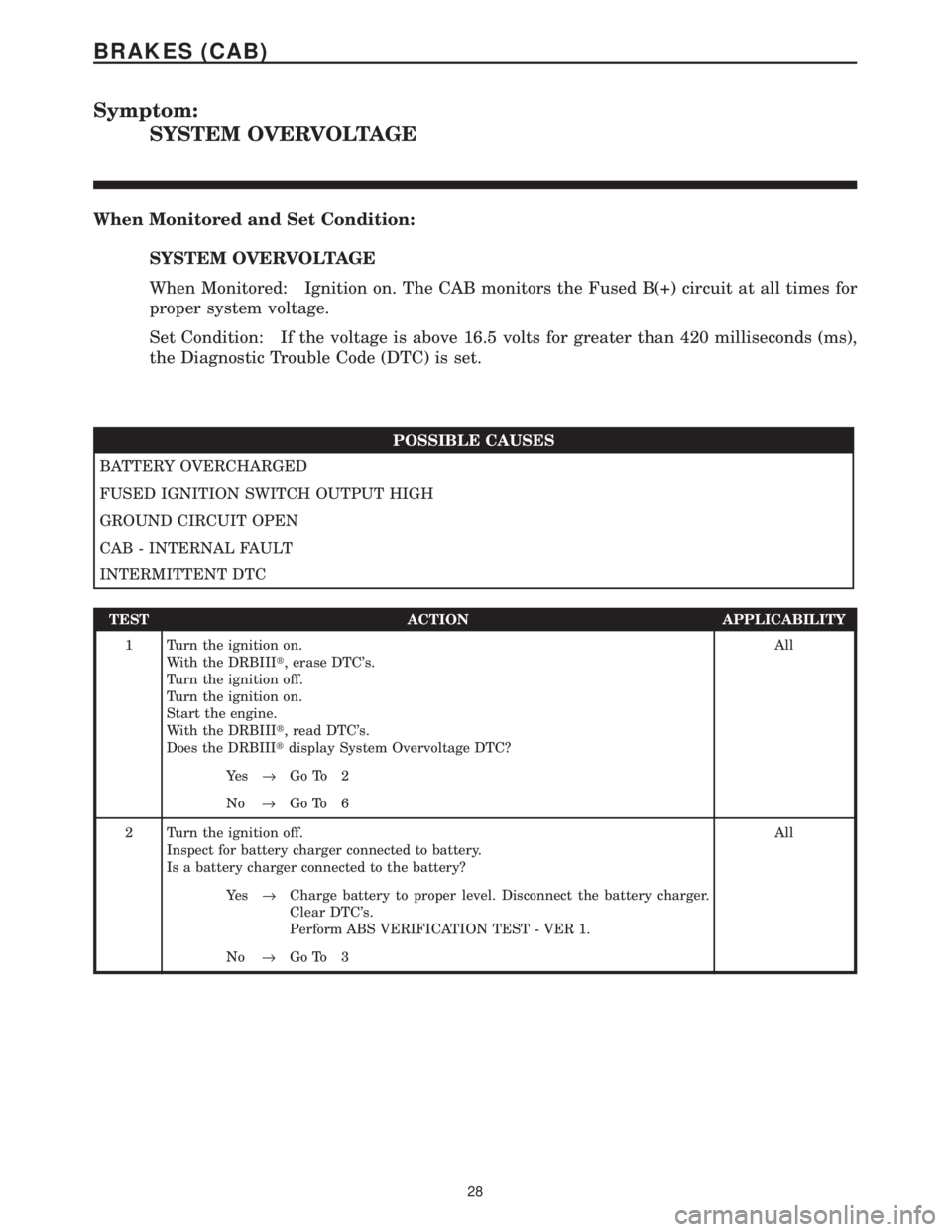
Symptom:
SYSTEM OVERVOLTAGE
When Monitored and Set Condition:
SYSTEM OVERVOLTAGE
When Monitored: Ignition on. The CAB monitors the Fused B(+) circuit at all times for
proper system voltage.
Set Condition: If the voltage is above 16.5 volts for greater than 420 milliseconds (ms),
the Diagnostic Trouble Code (DTC) is set.
POSSIBLE CAUSES
BATTERY OVERCHARGED
FUSED IGNITION SWITCH OUTPUT HIGH
GROUND CIRCUIT OPEN
CAB - INTERNAL FAULT
INTERMITTENT DTC
TEST ACTION APPLICABILITY
1 Turn the ignition on.
With the DRBIIIt, erase DTC's.
Turn the ignition off.
Turn the ignition on.
Start the engine.
With the DRBIIIt, read DTC's.
Does the DRBIIItdisplay System Overvoltage DTC?All
Ye s®Go To 2
No®Go To 6
2 Turn the ignition off.
Inspect for battery charger connected to battery.
Is a battery charger connected to the battery?All
Ye s®Charge battery to proper level. Disconnect the battery charger.
Clear DTC's.
Perform ABS VERIFICATION TEST - VER 1.
No®Go To 3
28
BRAKES (CAB)
Page 1187 of 4284
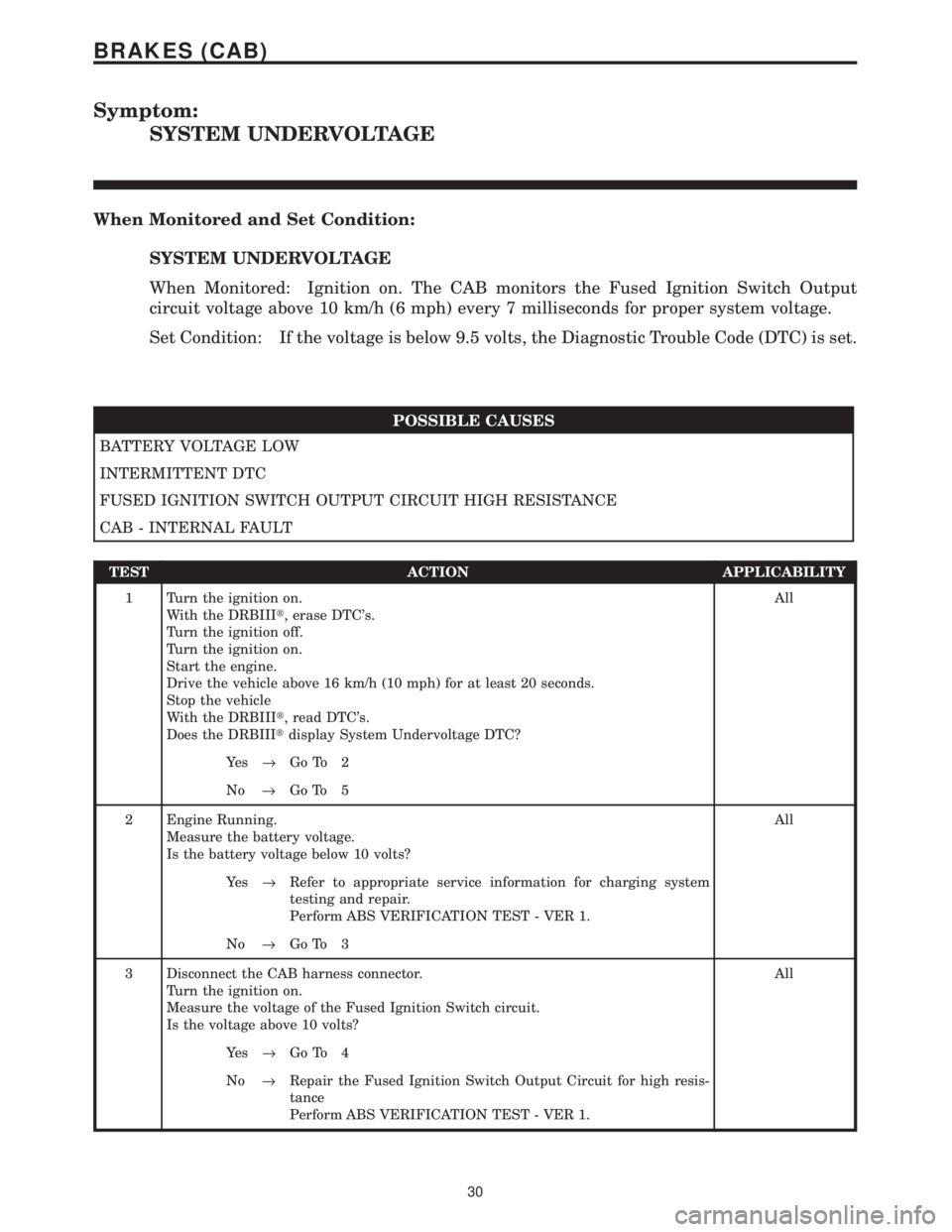
Symptom:
SYSTEM UNDERVOLTAGE
When Monitored and Set Condition:
SYSTEM UNDERVOLTAGE
When Monitored: Ignition on. The CAB monitors the Fused Ignition Switch Output
circuit voltage above 10 km/h (6 mph) every 7 milliseconds for proper system voltage.
Set Condition: If the voltage is below 9.5 volts, the Diagnostic Trouble Code (DTC) is set.
POSSIBLE CAUSES
BATTERY VOLTAGE LOW
INTERMITTENT DTC
FUSED IGNITION SWITCH OUTPUT CIRCUIT HIGH RESISTANCE
CAB - INTERNAL FAULT
TEST ACTION APPLICABILITY
1 Turn the ignition on.
With the DRBIIIt, erase DTC's.
Turn the ignition off.
Turn the ignition on.
Start the engine.
Drive the vehicle above 16 km/h (10 mph) for at least 20 seconds.
Stop the vehicle
With the DRBIIIt, read DTC's.
Does the DRBIIItdisplay System Undervoltage DTC?All
Ye s®Go To 2
No®Go To 5
2 Engine Running.
Measure the battery voltage.
Is the battery voltage below 10 volts?All
Ye s®Refer to appropriate service information for charging system
testing and repair.
Perform ABS VERIFICATION TEST - VER 1.
No®Go To 3
3 Disconnect the CAB harness connector.
Turn the ignition on.
Measure the voltage of the Fused Ignition Switch circuit.
Is the voltage above 10 volts?All
Ye s®Go To 4
No®Repair the Fused Ignition Switch Output Circuit for high resis-
tance
Perform ABS VERIFICATION TEST - VER 1.
30
BRAKES (CAB)
Page 1189 of 4284

Symptom:
VALVE POWER FEED FAILURE
When Monitored and Set Condition:
VALVE POWER FEED FAILURE
When Monitored: Ignition ON for at least 3.5 seconds. ABS Power Relay closed. Valve
command for a particular solenoid not present.
Set Condition: Low feedback voltage from the low side of all the solenoids for over 20
consecutive controller checks spaced 5 ms apart.
POSSIBLE CAUSES
INTERMITTENT DTC
BLOWN FUSE - FUSED B(+) CIRCUIT
NO B+ SUPPLY TO FUSE
FUSED B(+) CIRCUIT OPEN
B(+) CIRCUIT SHORTED TO GROUND
CAB - FUSED B(+) CIRCUIT OPEN
CAB - FUSED B(+) CIRCUIT SHORTED TO GROUND
TEST ACTION APPLICABILITY
1 Turn the ignition on.
With the DRBIIIt, erase DTC's.
Turn the ignition off.
Turn the ignition on.
Drive the vehicle above 25 km/h (15 mph) for at least 10 seconds.
Stop the vehicle.
With the DRBIIIt, read DTC's.
Does the DRBIIItdisplay Valve Power Feed Circuit DTC present right now?All
Ye s®Go To 2
No®Go To 9
2 Turn the ignition off.
Remove and Inspect the ABS Fuse 21 in the IPM.
Is the Fuse blown?All
Ye s®Go To 3
No®Go To 6
32
BRAKES (CAB)
Page 1190 of 4284
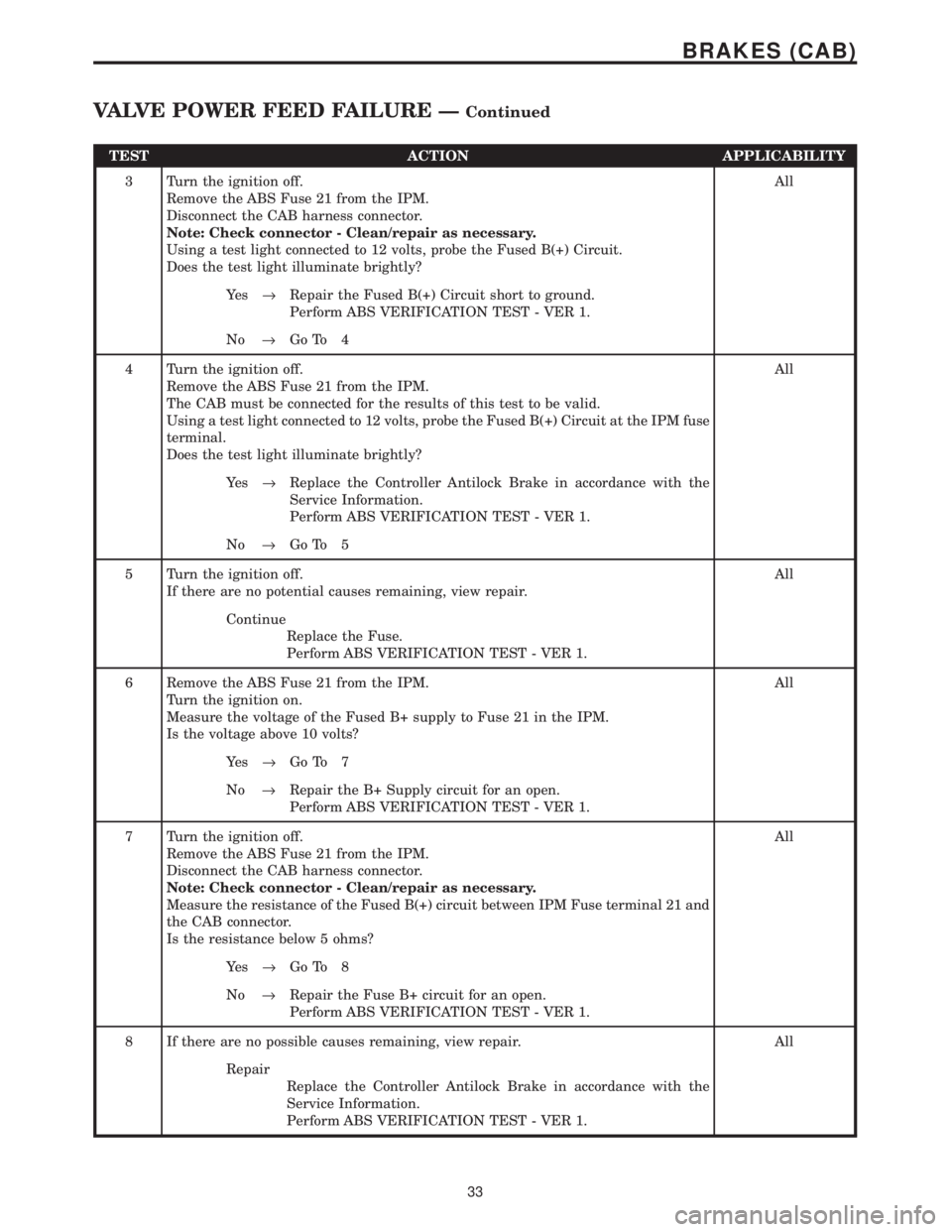
TEST ACTION APPLICABILITY
3 Turn the ignition off.
Remove the ABS Fuse 21 from the IPM.
Disconnect the CAB harness connector.
Note: Check connector - Clean/repair as necessary.
Using a test light connected to 12 volts, probe the Fused B(+) Circuit.
Does the test light illuminate brightly?All
Ye s®Repair the Fused B(+) Circuit short to ground.
Perform ABS VERIFICATION TEST - VER 1.
No®Go To 4
4 Turn the ignition off.
Remove the ABS Fuse 21 from the IPM.
The CAB must be connected for the results of this test to be valid.
Using a test light connected to 12 volts, probe the Fused B(+) Circuit at the IPM fuse
terminal.
Does the test light illuminate brightly?All
Ye s®Replace the Controller Antilock Brake in accordance with the
Service Information.
Perform ABS VERIFICATION TEST - VER 1.
No®Go To 5
5 Turn the ignition off.
If there are no potential causes remaining, view repair.All
Continue
Replace the Fuse.
Perform ABS VERIFICATION TEST - VER 1.
6 Remove the ABS Fuse 21 from the IPM.
Turn the ignition on.
Measure the voltage of the Fused B+ supply to Fuse 21 in the IPM.
Is the voltage above 10 volts?All
Ye s®Go To 7
No®Repair the B+ Supply circuit for an open.
Perform ABS VERIFICATION TEST - VER 1.
7 Turn the ignition off.
Remove the ABS Fuse 21 from the IPM.
Disconnect the CAB harness connector.
Note: Check connector - Clean/repair as necessary.
Measure the resistance of the Fused B(+) circuit between IPM Fuse terminal 21 and
the CAB connector.
Is the resistance below 5 ohms?All
Ye s®Go To 8
No®Repair the Fuse B+ circuit for an open.
Perform ABS VERIFICATION TEST - VER 1.
8 If there are no possible causes remaining, view repair. All
Repair
Replace the Controller Antilock Brake in accordance with the
Service Information.
Perform ABS VERIFICATION TEST - VER 1.
33
BRAKES (CAB)
VALVE POWER FEED FAILURE ÐContinued